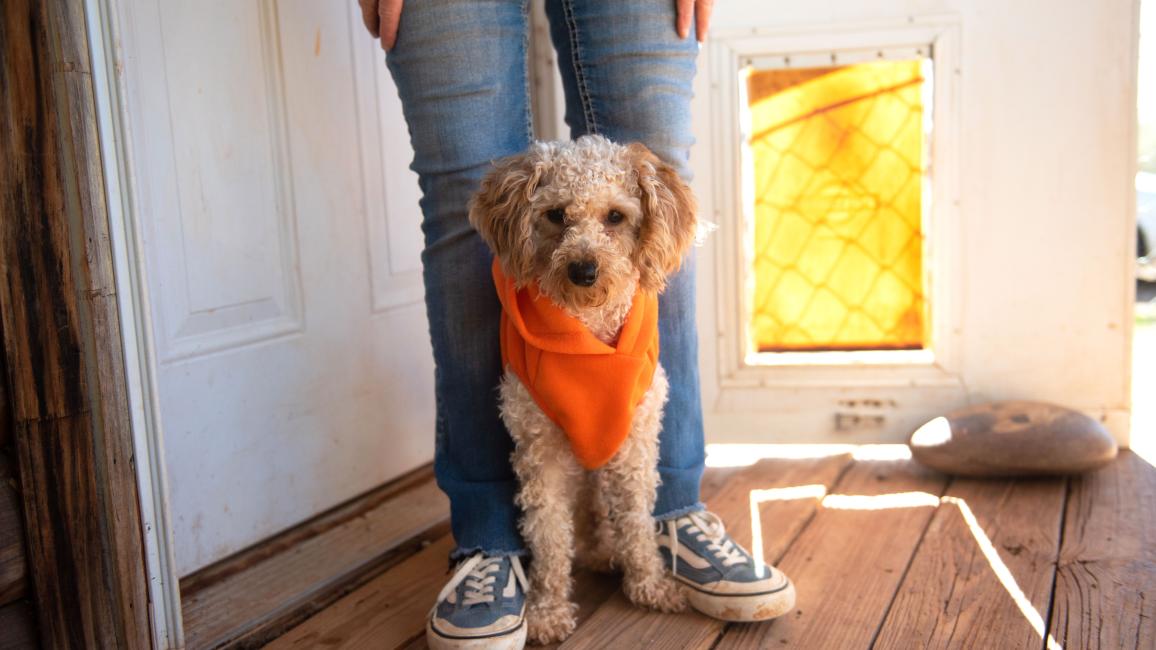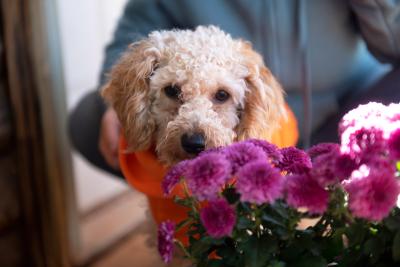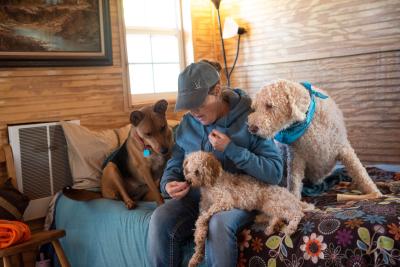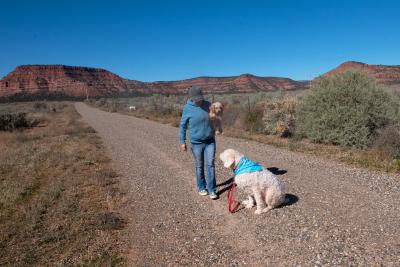Blind miniature poodle pup blossoms in foster home

Edna’s earliest days are a bit of a mystery, but they couldn’t have been easy. She was born in a breeding facility that soon quietly surrendered her to a rescue organization because she could not be sold. She was blind and had a neurological condition called cerebellar hypoplasia (CH), which meant she was shaky and wobbly as she moved around. And when she was handed over, she was covered in scabs and scratches, scared of everything and pretty shut down.
She also had episodes that seemed like seizures, which would cause her to growl and bite her blankets and toys. She could go on like that for a long time, though she had never redirected onto people or other dogs.
It was clear Edna needed help. She needed extra time and medical attention to figure out everything that was going on, so she could heal and get ready for a real home. So, Edna was brought to Best Friends Animal Sanctuary.

Unraveling a poodle’s past trauma
Edna’s first stop was the Best Friends Animal Clinic, where veterinarians gave her a thorough checkup and treated her scrapes. Though no treatment exists for her blindness or CH, she stayed at the clinic for a few days so that caregivers could observe her episodes of attacking blankets and toys. They seemed to be triggered by other dogs and new situations, which was tough because the clinic is a busy place with pets and people coming and going constantly.
Seizure medications didn’t help, either. No matter what: As soon as Edna heard or smelled another dog, she grabbed onto her bedding and started gnawing. She was stressed and needed a change of scenery And, as it turns out, some time in a foster finally started turning things around.
Edna went home with clinic staff member Kathy Moore, who felt a special connection to the curly-haired little dog. And as Kathy spent more time with her, she began to suspect Edna’s episodes might not be medical but behavioral. When she brought up the theory to the veterinarians, they agreed it made sense.
Edna can’t see and doesn’t have full control of her body, and her scabs suggested she had some sort of unpleasant incident with other animals before being surrendered. Kathy says, “When she’s overwhelmed, she’ll either do the (blanket) thing, or she’ll completely shut down and sleep.”
The good news: Since it was a behavioral response rather than seizures, Kathy and her own friendly canine companions, Max and Astrid, would be able to help Edna. At first, Kathy kept her dogs apart from Edna to ensure a slow, extended introduction while she was focusing on building Edna’s confidence. A new medication — this time for anxiety instead of seizures — also helped.
[Wobbly kitten is steadfast lover of life]
To help Edna with her balance, Kathy set up an empty exercise pen to give her an easy-to-navigate space where she could practice walking around. Then, she introduced treats for Edna to sniff out and track down. And when Edna was moving easily from one end to the next (and from treat to treat), Kathy added boxes and small obstacles for Edna to pick her way around.
While she learning to balance and navigate in this space, and snuggling with Kathy during breaks, Edna was getting used to the nearby sounds and smells of Astrid and Max. She felt comfortable with Kathy, and she made herself a safe space in her kennel where she was free to retreat if needed. She was finding her footing and getting used to her surroundings without these other dogs invading her space or bothering her. And slowly, she started to relax.

The puppy starts to play
Edna became an adventure dog. When it was time for a walk, the pup who previously couldn’t balance and panicked the first time she was on the front porch, charged down the driveway with Kathy jogging behind her to keep up.
“She’s gotten to the point now where she can not only be outside, but she comes outside and she plays,” Kathy says. “In the beginning, when she got frustrated (like if her food stuck to the bottom of the bowl), she would get really upset. But now she can usually do it without getting too upset.”
Edna started going everywhere with Kathy, including to work at the clinic. She needed to relearn balance and figure out how to navigate again because, Kathy says, she doesn’t really generalize experiences. “She can walk in the places she knows but she has to start all over again in new places. Typically, it takes a while to learn a familiar thing in a new context.”
As long as Edna had time to learn, Kathy’s help and they paid attention to when the pooch patients would be coming through, Edna was a content little desk dog.
Finally, after a several months of being in the same space as Max and Astrid without any direct interactions, Edna stuck her nose through the gate separating them, sniffed and didn’t panic. “Then, two days later they started playing,” says Kathy, “and it was wild right from the beginning.”
[Lessons from one blind dog led adopters to another]
It was like a dam had broken: Edna was excited to play and Astrid was happy to indulge her. (Max decided the bed was the safest spot to stay out of their way.) Astrid taught the poodle pup how to wrestle. They ran back and forth with a sock, and then they flopped over on the bed and wrestled some more with just their faces. It was Astrid who ran out of energy first.
“I think it was confidence building, but kind of a little too exciting at the same time,” Kathy says with a laugh. “She just kept going and going … and Astrid’s like, ‘I’m tired.’”
Edna still has moments when she’s overwhelmed by new things and too much roughhousing, both of which cause her to yelp and call off the game. The sound of other dogs eating and the behavior of certain dogs in the clinic can still upset her to the point where she runs to her toys and blankets. But, more and more, Edna is able to handle the things that once scared her so much.
“She’s good in her bubble,” Kathy says. “We just need to start increasing her bubbles … I have to be really organized. But with the time for her to learn all these things before she goes into a home, it’s going to set her up for success.”

Help a pet on their way to a home
Fostering pets like Edna can help them recover and find their footing. Plus, you get a fluffy friend out of it. It’s a win-win!
Read more
Blind puppy learns how to navigate his world